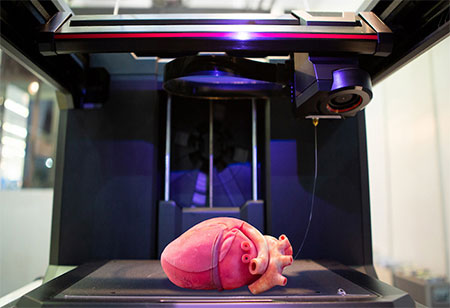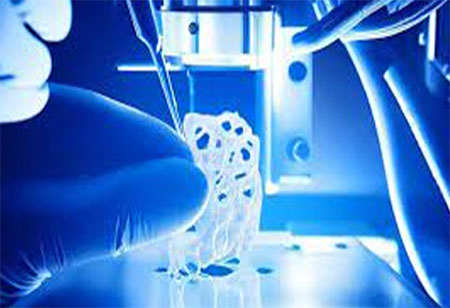Bramhanapalli Nalini, Content Writer

Bioprinting is a cutting-edge biotechnology innovation that is significant due to its potential to revolutionize healthcare, research and personalized medicine. With the help of this cutting-edge technique, functional tissues and organs may be created by precisely layering biological components, opening up previously unheard-of possibilities for organ transplantation and rege- nerative medicine. The potential of bioprinting to produce organs that are specifically designed to lower the risk of rejection makes it significant in addressing the global organ scarcity dilemma. It also speeds up the creation of new treatments, reduces the need for animal testing, and provides more accurate in vitro models, all of which contribute to the acceleration of drug testing and development.
In addition, bioprinting advances our grasp of intricate biological processes, expanding our understanding of diseases and facilitating the creation of specialized remedies. With future development, the method might be used to create complex circulatory networks inside printed tissues, expanding its potential uses. All things considered, bioprinting is a vital instrument for pushing the boundaries of biotechnology, providing creative answers to pressing problems in medicine and science that have the potential to completely transform how we treat patients and comprehend the human body.
The revolutionary technology of bioprinting provides numerous advantages for the medical field and other fields. It promotes improvements in organ transplantation, customized medicine, and drug testing by making it possible to precisely fabricate functional tissues and organs. This novel strategy expedites medicine development, lowers the chance of transplant rejection, and lessens reliance on organ donors—all of which eventually save lives. Additionally, bioprinting supports moral substitutes for animal testing that are in line with compassionate and environmentally friendly research methods. As this discipline develops, it has enormous potential to improve patient outcomes, transform medical treatments, and pave the way for a more ethical and sustainable future in biotechnology.
The global 3D bio-printing market is expected to reach US$ 2.24 billion by 2024. The demand for 3D bioprinting is anticipated to be worth US$ 6.82 billion by 2034. From 2024 to 2034, the market is expected to expand at an impressive CAGR of 11.8%.
"Biotechnology is not just a scientific discipline; it's a catalyst for social and economic transformation, reshaping the way we live and heal” - Kiran Mazumdar-Shaw, Biocon Founder
The Future of Bioprinting & Its Impact on Future Generations
Bioprinting is anticipated to ease the severe organ shortage in the next years by offering individualized and easily accessible substitutes. Through the reduction of organ rejection risk and the mitigation of transplantation waiting lists, this invention has the potential to save countless lives. Furthermore, by enabling researchers to examine the effects of novel drugs on tissues similar to humans, the technique has the potential to completely transform drug testing and increase the precision and effectiveness of pharmaceutical development. Beyond medical, bioprinting has consequences for environmental sustainability. For example, using bioprinting to cultivate meat could lessen the environmental impact of conventional animal husbandry. It is essentially a symptom of a paradigm change in healthcare and other fields. Its advancements point to a day when regenerative medicine is widely used, greatly enhancing the standard and accessibility of healthcare for future generations.
 Exploring the Fascinating Techniques of Bioprinting
Exploring the Fascinating Techniques of Bioprinting
Extrusion Bioprinting
Tissue engineering and regenerative medicine greatly benefit from extrusion bioprinting. With the aid of this Advanced technology, three-dimensional tissue structures may be precisely created by layer-by-layer deposition of bioinks, which are made of biomaterials and living cells. Extrusion bioprinting has several advantages.
First of all, it makes it easier to customize intricate tissue stru- ctures, which makes it possible to recreate detailed anatomical features. This degree of accuracy is essential for creating functional organs that are suited to the requirements of each patient. Extrusion bioprinting further speeds up the construction process, which makes it a viable remedy for the lack of organ transplants.
Second, the construction of heterogeneous tissues that closely resemble natural structures is made possible by the bioink's capacity to include different cell types. Because of this variety, the printed tissues operate better and have greater physiological relevance.
Furthermore, extrusion bioprinting is scalable, which makes it appropriate for producing tissues and organs on a big scale. This scalability offers a dependable and effective way to generate tissues for drug testing and transplantation, which has the potential to completely transform the medical industry.
To sum up, extrusion bioprinting is important because it has the potential to transform tissue engineering and offer specialized, useful solutions with a wide range of uses in the medical field and other fields.
Inkjet-based Bioprinting
At the forefront of ground-breaking developments in tissue engineering and regenerative medicine is inkjet-based bioprinting. This novel approach makes use of inkjet printers that precisely deposit bio-inks made of live cells, which enable the construction of intricate three-dimensional structures that closely resemble natural tissues. This innovation is significant because it has the potential to transform drug testing, illness modeling, and organ transplantation.
For instance, inkjet bioprinting provides a means of addressing the grave organ scarcity. It has the potential to minimize the risk of organ rejection in personalized organ transplants by enabling the manufacture of functional tissues with patient-specific cells. Furthermore, by lowering reliance on animal models, increasing the predictability of human reactions, and offering a platform for more precise and effective testing on bioprinted tissues, this technology speeds up the discovery of new drugs.
Additionally, inkjet bioprinting makes it easier to create disease models, which gives researchers a better understanding of the complexities of different disorders. This advances our knowledge of how diseases progress and speeds up the creation of targeted medicines.
In summary, inkjet-based bioprinting heralds a new chapter in the history of biomedical research, one that will facilitate the creation of effective medications, individualized treatment plans, and eventually better patient outcomes.